Escaping from Air Pollution: Exploring the Psychological Mechanism behind the Emergence of Internal Migration Intention among Urban Residents
Abstract
:1. Introduction
2. Theoretical Foundation
- First, the association between AirSatisfaction and MigratIntention needs to be negative.
- Second, the association between AirSatisfaction and MigratIntention has to be intensified (or positively moderated) by the perceived availability of options with better air quality. Here, we determined to treat NearbyMigratOpt and FarawayMigratOpt variables as moderating variables to turn their effects into non-linear (moderation) to avoid multicollinearity and confounding problems among predictor variables. We intentionally exclude the linear terms of MigratIntention with NearbyMigratOpt and FarawayMigratOpt because the model without them fits that data better than the model adding them (see Supplementary S1 for detailed comparison). Furthermore, excluding those linear terms can make the estimated results more understandable.
- Third, to evaluate the effect of moving distance, we compare the moderation effects of NearbyMigratOpt and FarawayMigratOpt. If the moderation effect of FarawayMigratOpt is smaller than that of NearbyMigratOpt, our assumption that migration distance increases the perceived cost of migration, leading to lower migration likelihood, is valid. If their effects are equal or the effect of NearbyMigratOpt is smaller, our assumption will be invalid, as will our proposed psychological mechanism.
3. Materials and Methods
3.1. Materials
3.2. Methods and Validation
4. Results
4.1. Model 1: Migration Cost–Benefit Judgment
4.2. Model 2: Incorporation of Socio-Demographic Factors
4.3. Model Comparison and Migration Probability Visualization
5. Discussion
6. Conclusions
Supplementary Materials
Author Contributions
Funding
Institutional Review Board Statement
Informed Consent Statement
Data Availability Statement
Conflicts of Interest
Appendix A
| Variable | Level | Samples (N = 475) | Proportion |
|---|---|---|---|
| MigratIntention | No = 0 | 430 | 90.53% |
| Yes = 1 | 44 | 9.26% | |
| AirSatisfaction | Very dissatisfied = 1 | 102 | 21.47% |
| Dissatisfied = 2 | 237 | 49.89% | |
| Neutral = 3 | 111 | 23.37% | |
| Satisfied = 4 | 20 | 4.21% | |
| Very satisfied = 5 | 2 | 0.42% | |
| NearbyMigratOpt | No = 0 | 85 | 17.89% |
| Yes = 1 | 390 | 82.11% | |
| FarawayMigratOpt | No = 0 | 323 | 68.00% |
| Yes = 1 | 152 | 32.00% | |
| AgeGroup | From 10 to 18 = 1 | 8 | 1.68% |
| From 19 to 30 = 2 | 142 | 29.89% | |
| From 31 to 40 = 3 | 109 | 22.95% | |
| From 41 to 50 = 4 | 63 | 13.26% | |
| From 51 to 60 = 5 | 61 | 12.84% | |
| Above 60 = 6 | 92 | 19.37% | |
| Gender | Female = 0 | 215 | 45.26% |
| Male = 1 | 259 | 54.53% | |
| Education | Secondary school or below = 1 | 53 | 11.16% |
| High school = 2 | 132 | 27.79% | |
| Technical school, college degree, university degree = 3 | 265 | 55.79% | |
| Master’s degree = 4 | 19 | 4.00% | |
| Doctoral degree = 5 | 2 | 0.42% |
References
- WHO. Air Pollution. Available online: https://www.who.int/health-topics/air-pollution (accessed on 18 March 2022).
- Zivin, J.G.; Neidell, M. Days of haze: Environmental information disclosure and intertemporal avoidance behavior. J. Environ. Econ. Manag. 2009, 58, 119–128. [Google Scholar] [CrossRef]
- Deschenes, O.; Greenstone, M.; Shapiro, J.S. Defensive investments and the demand for air quality: Evidence from the NOx budget program. Am. Econ. Rev. 2017, 107, 2958–2989. [Google Scholar] [CrossRef]
- Zhang, J.; Mu, Q. Air pollution and defensive expenditures: Evidence from particulate-filtering facemasks. J. Environ. Econ. Manag. 2018, 92, 517–536. [Google Scholar] [CrossRef]
- Iqair. World Air Quality Report 2019—Region and City PM2.5 Ranking; Iqair: Goldach, Switzerland, 2019. [Google Scholar]
- Lu, J.G. Air pollution: A systematic review of its psychological, economic, and social effects. Curr. Opin. Psychol. 2020, 32, 52–65. [Google Scholar] [CrossRef]
- Sass, V.; Kravitz-Wirtz, N.; Karceski, S.M.; Hajat, A.; Crowder, K.; Takeuchi, D. The effects of air pollution on individual psychological distress. Heal. Place 2017, 48, 72–79. [Google Scholar] [CrossRef] [PubMed]
- Kim, K.-N.; Lim, Y.-H.; Bae, H.J.; Kim, M.; Jung, K.; Hong, Y.-C. Long-Term Fine Particulate Matter Exposure and Major Depressive Disorder in a Community-Based Urban Cohort. Environ. Health Perspect. 2016, 124, 1547–1553. [Google Scholar] [CrossRef]
- Vert, C.; Sánchez-Benavides, G.; Martínez, D.; Gotsens, X.; Gramunt, N.; Cirach, M.; Molinuevo, J.L.; Sunyer, J.; Nieuwenhuijsen, M.J.; Crous-Bou, M.; et al. Effect of long-term exposure to air pollution on anxiety and depression in adults: A cross-sectional study. Int. J. Hyg. Environ. Health 2017, 220, 1074–1080. [Google Scholar] [CrossRef]
- Casas, L.; Cox, B.; Bauwelinck, M.; Nemery, B.; Deboosere, P.; Nawrot, T.S. Does air pollution trigger suicide? A case-crossover analysis of suicide deaths over the life span. Eur. J. Epidemiol. 2017, 32, 973–981. [Google Scholar] [CrossRef]
- Kim, Y.; Ng, C.F.S.; Chung, Y.; Kim, H.; Honda, Y.; Guo, Y.L.; Lim, Y.-H.; Chen, B.-Y.; Page, L.A.; Hashizume, M. Air Pollution and Suicide in 10 Cities in Northeast Asia: A Time-Stratified Case-Crossover Analysis. Environ. Health Perspect. 2018, 126, 037002. [Google Scholar] [CrossRef] [PubMed]
- Szyszkowicz, M.; Willey, J.B.; Grafstein, E.; Rowe, B.H.; Colman, I. Air Pollution and Emergency Department Visits for Suicide Attempts in Vancouver, Canada. Environ. Health Insights 2010, 4, 79–86. [Google Scholar] [CrossRef] [PubMed]
- Claeson, A.-S.; Lidén, E.; Nordin, M.; Nordin, S. The role of perceived pollution and health risk perception in annoyance and health symptoms: A population-based study of odorous air pollution. Int. Arch. Occup. Environ. Health 2013, 86, 367–374. [Google Scholar] [CrossRef] [PubMed]
- Sunyer, J.; Esnaola, M.; Alvarez-Pedrerol, M.; Forns, J.; Rivas, I.; López-Vicente, M.; Suades-González, E.; Foraster, M.; Garcia-Esteban, R.; Basagaña, X.; et al. Association between Traffic-Related Air Pollution in Schools and Cognitive Development in Primary School Children: A Prospective Cohort Study. PLoS Med. 2015, 12, e1001792. [Google Scholar] [CrossRef]
- Chiu, Y.-H.M.; Bellinger, D.C.; Coull, B.A.; Anderson, S.; Barber, R.; Wright, R.O.; Wright, R.J. Associations between Traffic-Related Black Carbon Exposure and Attention in a Prospective Birth Cohort of Urban Children. Environ. Health Perspect. 2013, 121, 859. [Google Scholar] [CrossRef] [PubMed]
- Mohai, P.; Kweon, B.-S.; Lee, S.; Ard, K. Air Pollution Around Schools Is Linked To Poorer Student Health And Academic Performance. Health Aff. 2011, 30, 852–862. [Google Scholar] [CrossRef] [PubMed]
- Chen, J.-C.; Schwartz, J. Neurobehavioral effects of ambient air pollution on cognitive performance in US adults. Neurotoxicology 2009, 30, 231–239. [Google Scholar] [CrossRef]
- Zhang, X.; Chen, X.; Zhang, X. The impact of exposure to air pollution on cognitive performance. Proc. Natl. Acad. Sci. USA 2018, 115, 9193–9197. [Google Scholar] [CrossRef]
- Ranft, U.; Schikowski, T.; Sugiri, D.; Krutmann, J.; Krämer, U. Long-term exposure to traffic-related particulate matter impairs cognitive function in the elderly. Environ. Res. 2009, 109, 1004–1011. [Google Scholar] [CrossRef]
- Oudin, A.; Forsberg, B.; Adolfsson, A.N.; Lind, N.; Modig, L.; Nordin, M.; Nordin, S.; Adolfsson, R.; Nilsson, L.-G. Traffic-Related Air Pollution and Dementia Incidence in Northern Sweden: A Longitudinal Study. Environ. Health Perspect. 2016, 124, 306–312. [Google Scholar] [CrossRef]
- Li, T.; Liu, H.; Salvo, A. Severe Air Pollution and Labor Productivity; Institute for the Study of Labor (IZA): Bonn, Germany, 2015. [Google Scholar] [CrossRef]
- Chang, T.Y.; Graff Zivin, J.; Gross, T.; Neidell, M. The effect of pollution on worker productivity: Evidence from call center workers in China. Am. Econ. Journal: Appl. Econ. 2019, 11, 151–172. [Google Scholar] [CrossRef] [Green Version]
- Wolf, M.J.; Emerson, J.W.; Esty, D.C.; Sherbinin, A.d.; Wendling, Z.A. 2022 Environmental Performance Index; Yale Center for Environmental Law & Policy: New Haven, CT, USA, 2022. [Google Scholar]
- Nguyen, Q. Hanoi Ranked World’s Seventh Most Polluted Capital City in 2019. Available online: https://e.vnexpress.net/news/news/hanoi-ranked-world-s-seventh-most-polluted-capital-city-in-2019-4061412.html (accessed on 22 September 2022).
- Hien, P.; Men, N.; Tan, P.; Hangartner, M. Impact of urban expansion on the air pollution landscape: A case study of Hanoi, Vietnam. Sci. Total Environ. 2020, 702, 134635. [Google Scholar] [CrossRef]
- Vu Van, H.; Le Xuan, Q.; Pham Ngoc, H.; Luc, H. Health risk assessment of mobility-related air pollution in Ha Noi, Vietnam. J. Environ. Prot. 2013, 4, 1165–1172. [Google Scholar] [CrossRef]
- Luong, L.M.; Phung, D.; Sly, P.D.; Morawska, L.; Thai, P.K. The association between particulate air pollution and respiratory admissions among young children in Hanoi, Vietnam. Sci. Total Environ. 2017, 578, 249–255. [Google Scholar] [CrossRef]
- Phung, D.; Hien, T.T.; Linh, H.N.; Luong, L.M.; Morawska, L.; Chu, C.; Binh, N.D.; Thai, P.K. Air pollution and risk of respiratory and cardiovascular hospitalizations in the most populous city in Vietnam. Sci. Total Environ. 2016, 557, 322–330. [Google Scholar] [CrossRef]
- Nhung, N.T.T.; Schindler, C.; Dien, T.M.; Probst-Hensch, N.; Perez, L.; Künzli, N. Acute effects of ambient air pollution on lower respiratory infections in Hanoi children: An eight-year time series study. Environ. Int. 2018, 110, 139–148. [Google Scholar] [CrossRef]
- Bresnahan, B.W.; Dickie, M.; Gerking, S. Averting Behavior and Urban Air Pollution. Land Econ. 1997, 73, 340. [Google Scholar] [CrossRef]
- Currie, J.; Hanushek, E.A.; Kahn, E.M.; Neidell, M.; Rivkin, S.G. Does Pollution Increase School Absences? Rev. Econ. Stat. 2009, 91, 682–694. [Google Scholar] [CrossRef]
- Saberian, S.; Heyes, A.; Rivers, N. Alerts work! Air quality warnings and cycling. Resour. Energy Econ. 2017, 49, 165–185. [Google Scholar] [CrossRef]
- Noonan, D.S. Smoggy with a Chance of Altruism: The Effects of Ozone Alerts on Outdoor Recreation and Driving in Atlanta. Policy Stud. J. 2014, 42, 122–145. [Google Scholar] [CrossRef]
- Wolpert, J. Migration as an Adjustment to Environmental Stress. J. Soc. Issues 1966, 22, 92–102. [Google Scholar] [CrossRef]
- Gholipour, H.F.; Farzanegan, M.R.; Javadian, M. Air Pollution and Internal Migration: Evidence from Iranian Household Survey; CESifo Working Paper No. 8107; CESifo: Munich, Germany, 2020. [Google Scholar]
- Germani, A.R.; Scaramozzino, P.; Castaldo, A.; Talamo, G. Does air pollution influence internal migration? An empirical investigation on Italian provinces. Environ. Sci. Policy 2021, 120, 11–20. [Google Scholar] [CrossRef]
- Chen, S.; Oliva, P.; Zhang, P. The effect of air pollution on migration: Evidence from China. Natl. Bur. Econ. Res. 2017, 156, 24036. [Google Scholar] [CrossRef]
- Kim, B. Do Air Quality Alerts Affect Household Migration? South. Econ. J. 2019, 85, 766–795. [Google Scholar] [CrossRef]
- Liu, Z.; Yu, L. Stay or Leave? The Role of Air Pollution in Urban Migration Choices. Ecol. Econ. 2020, 177, 106780. [Google Scholar] [CrossRef]
- Koubi, V.; Stoll, S.; Spilker, G. Perceptions of environmental change and migration decisions. Clim. Chang. 2016, 138, 439–451. [Google Scholar] [CrossRef]
- Dessai, S.; Adger, W.N.; Hulme, M.; Turnpenny, J.; Köhler, J.; Warren, R. Defining and experiencing dangerous climate change. Clim. Chang. 2004, 64, 11–25. [Google Scholar] [CrossRef]
- Warner, K. Environmental change and migration: Methodological considerations from ground-breaking global survey. Popul. Environ. 2011, 33, 3–27. [Google Scholar] [CrossRef]
- Vuong, Q.H.; Napier, N.K. Acculturation and global mindsponge: An emerging market perspective. Int. J. Intercult. Relat. 2015, 49, 354–367. [Google Scholar] [CrossRef]
- Vuong, Q.-H.; Nguyen, M.-H.; La, V.-P. The Mindsponge and BMF Analytics for Innovative Thinking in Social Sciences and Humanities; De Gruyter: Berlin, Germany, 2022. [Google Scholar]
- Nguyen, M.-H.; La, V.-P.; Le, T.-T.; Vuong, Q.-H. Introduction to Bayesian Mindsponge Framework analytics: An innovative method for social and psychological research. MethodsX 2022, 9, 101808. [Google Scholar] [CrossRef]
- Nguyen, M.-H.; Le, T.-T.; Nguyen, H.-K.T.; Ho, M.-T.; Nguyen, H.T.T.; Vuong, Q.-H. Alice in Suicideland: Exploring the Suicidal Ideation Mechanism through the Sense of Connectedness and Help-Seeking Behaviors. Int. J. Environ. Res. Public Health 2021, 18, 3681. [Google Scholar] [CrossRef]
- Vuong, Q.-H. Mindsponge Theory; AISDL: Hanoi, Vietnam, 2022; Available online: https://books.google.com.vn/books? (accessed on 5 September 2022).
- Frey, B.S.; Luechinger, S.; Stutzer, A. The life satisfaction approach to valuing public goods: The case of terrorism. Public Choice 2009, 138, 317–345. [Google Scholar] [CrossRef]
- Welsch, H. Environment and happiness: Valuation of air pollution using life satisfaction data. Ecol. Econ. 2006, 58, 801–813. [Google Scholar] [CrossRef]
- Schwartz, A. Interpreting the Effect of Distance on Migration. J. Political Econ. 1973, 81, 1153–1169. [Google Scholar] [CrossRef]
- Halás, M.; Klapka, P. Revealing the structures of internal migration: A distance and a time-space behaviour perspectives. Appl. Geogr. 2021, 137, 102603. [Google Scholar] [CrossRef]
- Vuong, Q.-H.; Phu, T.V.; Le, T.-A.T.; Van Khuc, Q. Exploring Inner-City Residents’ and Foreigners’ Commitment to Improving Air Pollution: Evidence from a Field Survey in Hanoi, Vietnam. Data 2021, 6, 39. [Google Scholar] [CrossRef]
- Khuc, V.Q.; Phu, T.V.; Luu, P. Dataset on the Hanoian suburbanites’ perception and mitigation strategies towards air pollution. Data Brief 2020, 33, 106414. [Google Scholar] [CrossRef]
- Cebula, R.J.; Vedder, R.K. A Note on Migration, Economic Opportunity, and the Quality of Life. J. Reg. Sci. 1973, 13, 205–211. [Google Scholar] [CrossRef]
- Lee, E.S. A theory of migration. Demography 1966, 3, 47–57. [Google Scholar] [CrossRef]
- Tran, Q.H. Organisational culture, leadership behaviour and job satisfaction in the Vietnam context. Int. J. Organ. Anal. 2021, 29, 136–154. [Google Scholar] [CrossRef]
- Vuong, Q.H. Impacts of geographical locations and sociocultural traits on the Vietnamese entrepreneurship. SpringerPlus 2016, 5, 1189. [Google Scholar] [CrossRef] [Green Version]
- William. Hanoi vs. Ho Chi Minh City: Cultural Differences. Available online: https://vietnamdaily.ca/culture/hanoi-vs-ho-chi-minh-city-cultural-differences/ (accessed on 29 June 2022).
- Nguyen, M.-H.; La, V.-P.; Le, T.-T.; Vuong, Q.-H. Bayesian Mindsponge Framework analytics: A novel methodological approach for social sciences and humanities. In The Mindsponge and BMF Analytics for Innovative Thinking in Social Sciences and Humanities; Vuong, Q.-H., Nguyen, M.-H., La, V.-P., Eds.; De Gruyter: Berlin, Germany, 2022; pp. 87–116. [Google Scholar]
- Vuong, Q.-H.; Nguyen, M.-H.; Le, T.-T. A Mindsponge-Based Investigation into the Psycho-Religious Mechanism behind Suicide Attacks; Sciendo: Warsaw, Poland, 2021. [Google Scholar]
- Vuong, Q.-H.; Le, T.-T.; La, V.-P.; Nguyen, M.-H. The psychological mechanism of Internet information processing for post-treatment evaluation. Heliyon 2022, 8, E09351. [Google Scholar] [CrossRef]
- Khuc, Q.V.; Nguyen, M.-H.; Le, T.-T.; Nguyen, T.-L.; Nguyen, T.; Lich, H.K.; Vuong, Q.-H. Brain drain out of the blue: Pollution-induced migration in Vietnam. Int. J. Environ. Res. Public Health 2022, 19, 3645. [Google Scholar] [CrossRef]
- Vuong, Q.-H. A New Theory of Serendipity: Nature, Emergence and Mechanism; De Gruyter: Berlin, Germany, 2022. [Google Scholar]
- Baker, M. Over half of psychology studies fail reproducibility test. Nature 2015, 27, 1–3. [Google Scholar] [CrossRef]
- Open Science Collaboration. Estimating the reproducibility of psychological science. Science 2015, 349, aac4716. [Google Scholar] [CrossRef]
- Wagenmakers, E.-J.; Marsman, M.; Jamil, T.; Ly, A.; Verhagen, J.; Love, J.; Selker, R.; Gronau, Q.F.; Šmíra, M.; Epskamp, S. Bayesian inference for psychology. Part I: Theoretical advantages and practical ramifications. Psychon. Bull. Rev. 2018, 25, 35–57. [Google Scholar] [CrossRef]
- Csilléry, K.; Blum, M.G.; Gaggiotti, O.E.; François, O. Approximate Bayesian computation (ABC) in practice. Trends Ecol. Evol. 2010, 25, 410–418. [Google Scholar] [CrossRef]
- Kerkhoff, D.; Nussbeck, F.W. The influence of sample size on parameter estimates in three-level random-effects models. Front. Psychol. 2019, 10, 1067. [Google Scholar] [CrossRef]
- Dunson, D.B. Commentary: Practical Advantages of Bayesian Analysis of Epidemiologic Data. Am. J. Epidemiol. 2001, 153, 1222–1226. [Google Scholar] [CrossRef]
- McNeish, D. On using Bayesian methods to address small sample problems. Struct. Equ. Model. 2016, 23, 750–773. [Google Scholar] [CrossRef]
- Jaya, I.; Tantular, B.; Andriyana, Y. A Bayesian approach on multicollinearity problem with an Informative Prior. J. Phys. Conf. Ser. 2019, 1265, 012021. [Google Scholar] [CrossRef]
- Adepoju, A.A.; Ojo, O.O. Bayesian method for solving the problem of multicollinearity in regression. Afr. Stat. 2018, 13, 1823–1834. [Google Scholar]
- Leamer, E.E. Multicollinearity: A Bayesian interpretation. Rev. Econ. Stat. 1973, 55, 371–380. [Google Scholar] [CrossRef]
- Vuong, Q.-H.; Ho, M.-T.; Nguyen, M.-H.; Thang Hang, P.; Vuong, T.-T.; Khuc, Q.; Ho, H.-A.; La, V.-P. On the environment-destructive probabilistic trends: A perceptual and behavioral study on video game players. Technol. Soc. 2021, 65, 101530. [Google Scholar] [CrossRef]
- Vehtari, A.; Gelman, A.; Gabry, J. Practical Bayesian model evaluation using leave-one-out cross-validation and WAIC. Stat. Comput. 2017, 27, 1413–1432. [Google Scholar] [CrossRef]
- Vuong, Q.-H.; La, V.-P.; Nguyen, M.-H.; Ho, M.-T.; Tran, T.; Ho, M.-T. Bayesian analysis for social data: A step-by-step protocol and interpretation. MethodsX 2020, 7, 100924. [Google Scholar] [CrossRef]
- Vuong, Q.-H.; Nguyen, M.-H.; La, V.-P. Updated protocol for performing BMF analytics using bayesvl. In The Mindsponge and BMF Analytics for Innovative Thinking in Social Sciences and Humanities; Vuong, Q.-H., Nguyen, M.-H., La, V.-P., Eds.; De Gruyter: Berlin, Germany, 2022; pp. 301–370. [Google Scholar]
- McElreath, R. Statistical Rethinking: A Bayesian Course with Examples in R and Stan; Chapman and Hall/CRC Press: London, UK, 2018. [Google Scholar]
- Miller, E. A note on the role of distance in migration: Costs of mobility versus intervening opportunities. J. Reg. Sci. 1972, 12, 475–478. [Google Scholar] [CrossRef]
- Charness, G.; Gneezy, U. Strong evidence for gender differences in risk taking. J. Econ. Behav. Organ. 2012, 83, 50–58. [Google Scholar] [CrossRef]
- Eckel, C.C.; Grossman, P.J. Men, women and risk aversion: Experimental evidence. Handb. Exp. Econ. Results 2008, 1, 1061–1073. [Google Scholar]
- Nguyen, M.-H.; Nguyen, H.T.T.; Ho, M.-T.; Le, T.-T.; Vuong, Q.-H. The roles of female involvement and risk aversion in open access publishing patterns in Vietnamese social sciences and humanities. J. Data Inf. Sci. 2022, 7, 76–96. [Google Scholar] [CrossRef]
- Birchall, J. Gender, Age and Migration: An Extended Briefing; Institute of Development Studies: Falmer, UK, 2016. [Google Scholar]
- Kim, S.E.; Harish, S.; Kennedy, R.; Jin, X.; Urpelainen, J. Environmental degradation and public opinion: The case of air pollution in Vietnam. J. Environ. Dev. 2020, 29, 196–222. [Google Scholar] [CrossRef]
- Do, N.T. Vietnam’s Big Air Pollution Challenge. Available online: https://thediplomat.com/2020/03/vietnams-big-air-pollution-challenge/ (accessed on 14 March 2022).
- Park, K. Time to Take Bolder Actions for Clean Air and People’s Health. Available online: https://www.who.int/vietnam/news/commentaries/detail/time-to-take-bolder-actions-for-clean-air-and-people%E2%80%99s-health (accessed on 22 September 2022).
- Vuong, Q.-H.; Ho, M.-T.; Nguyen, H.-K.T.; Nguyen, M.-H. The trilemma of sustainable industrial growth: Evidence from a piloting OECD’s Green city. Palgrave Commun. 2019, 5, 156. [Google Scholar] [CrossRef]
- Vuong, Q.-H. The (ir)rational consideration of the cost of science in transition economies. Nat. Hum. Behav. 2018, 2, 5. [Google Scholar] [CrossRef]
- Vuong, Q.H. The semiconducting principle of monetary and environmental values exchange. Econ. Bus. Lett. 2021, 10, 284–290. [Google Scholar] [CrossRef]
- Vuong, Q.-H. Reform retractions to make them more transparent. Nature 2020, 582, 149. [Google Scholar] [CrossRef]


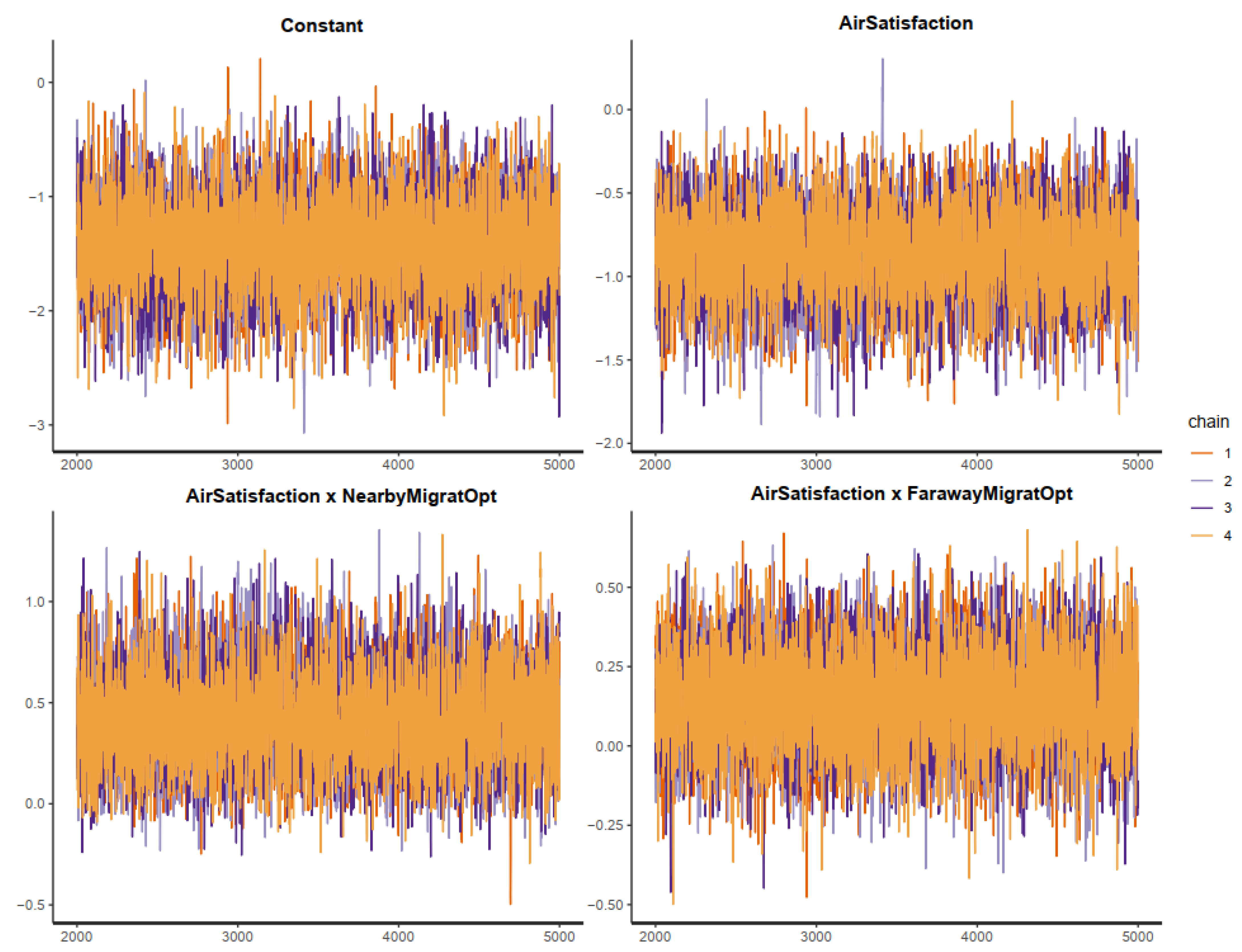

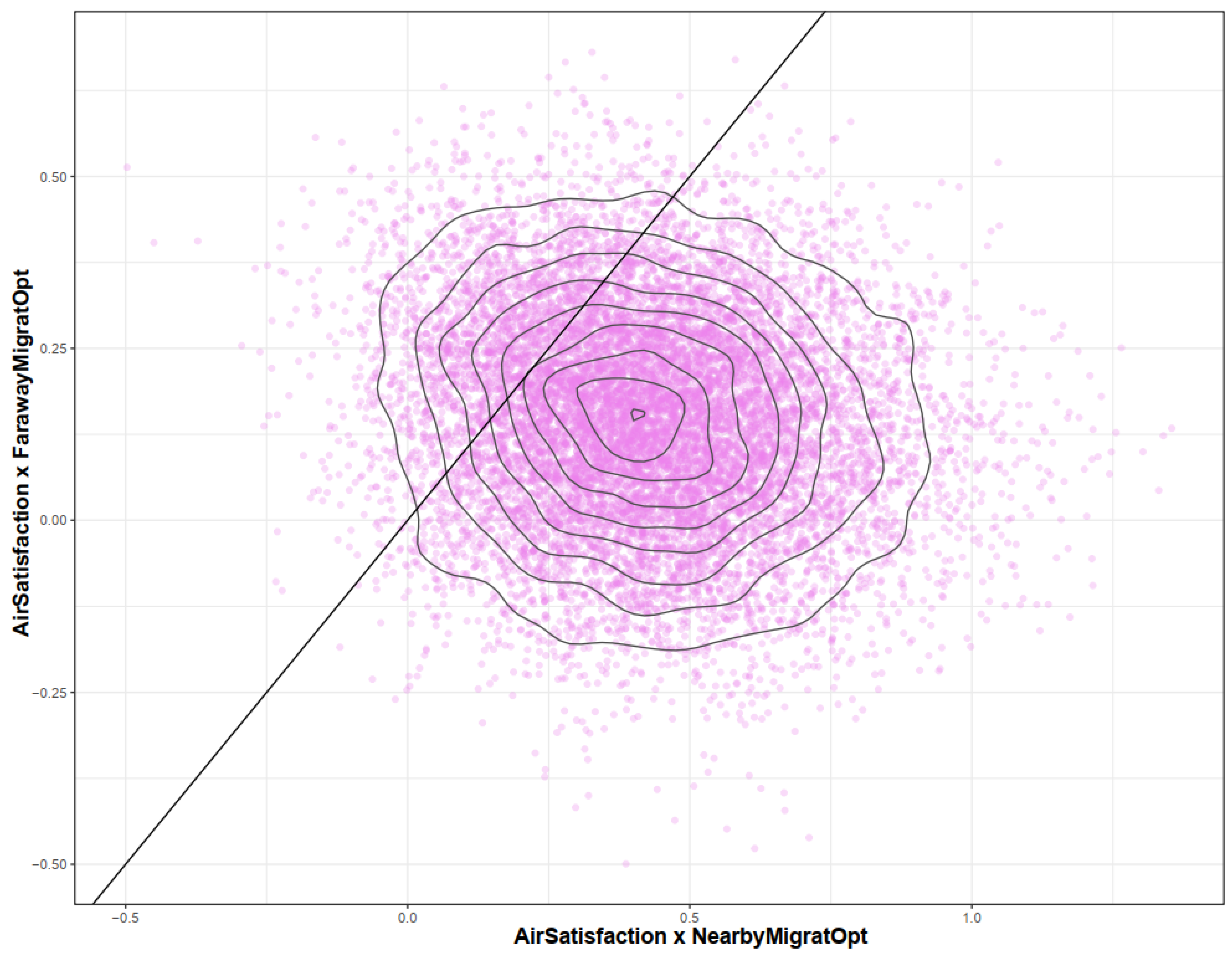
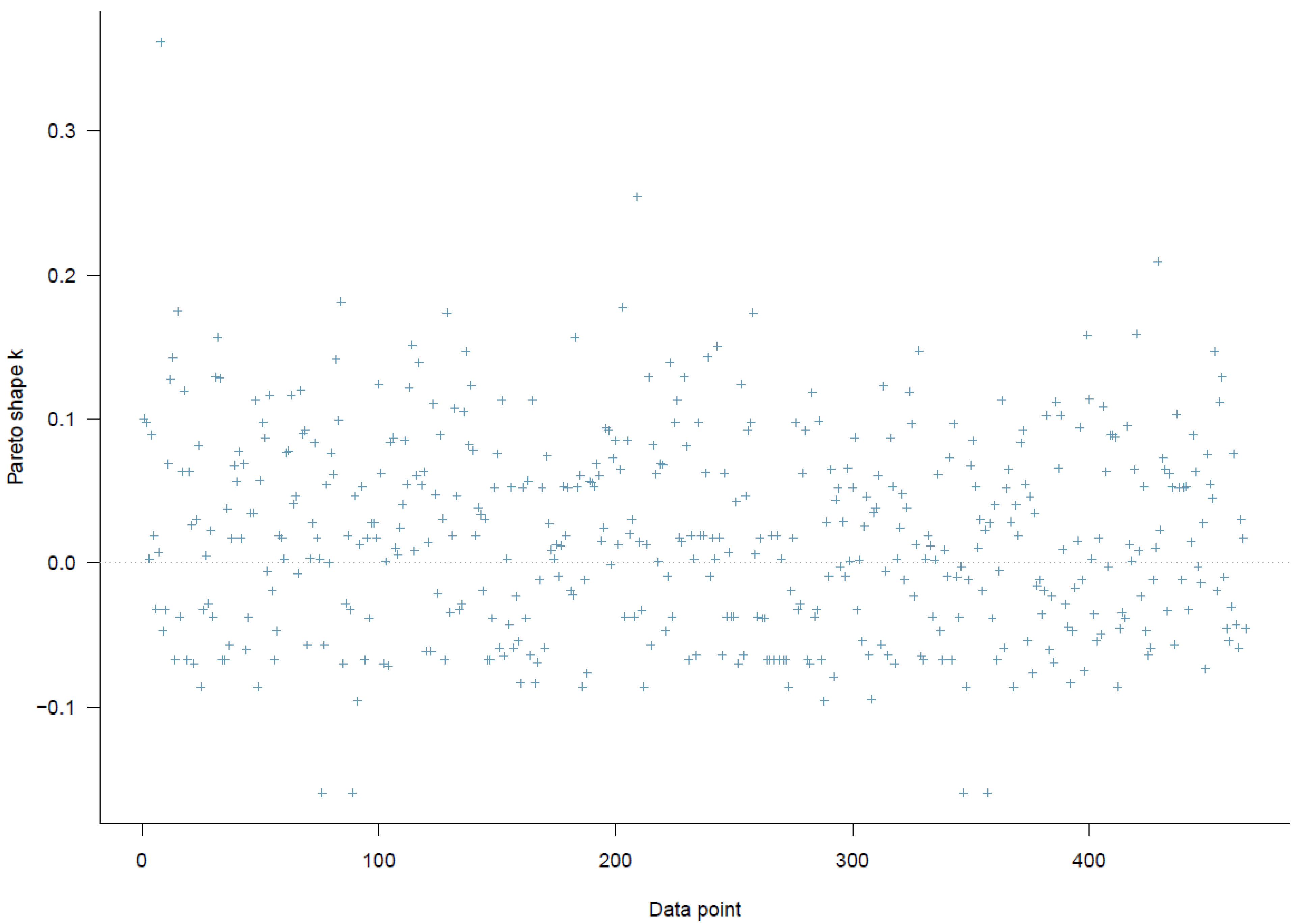
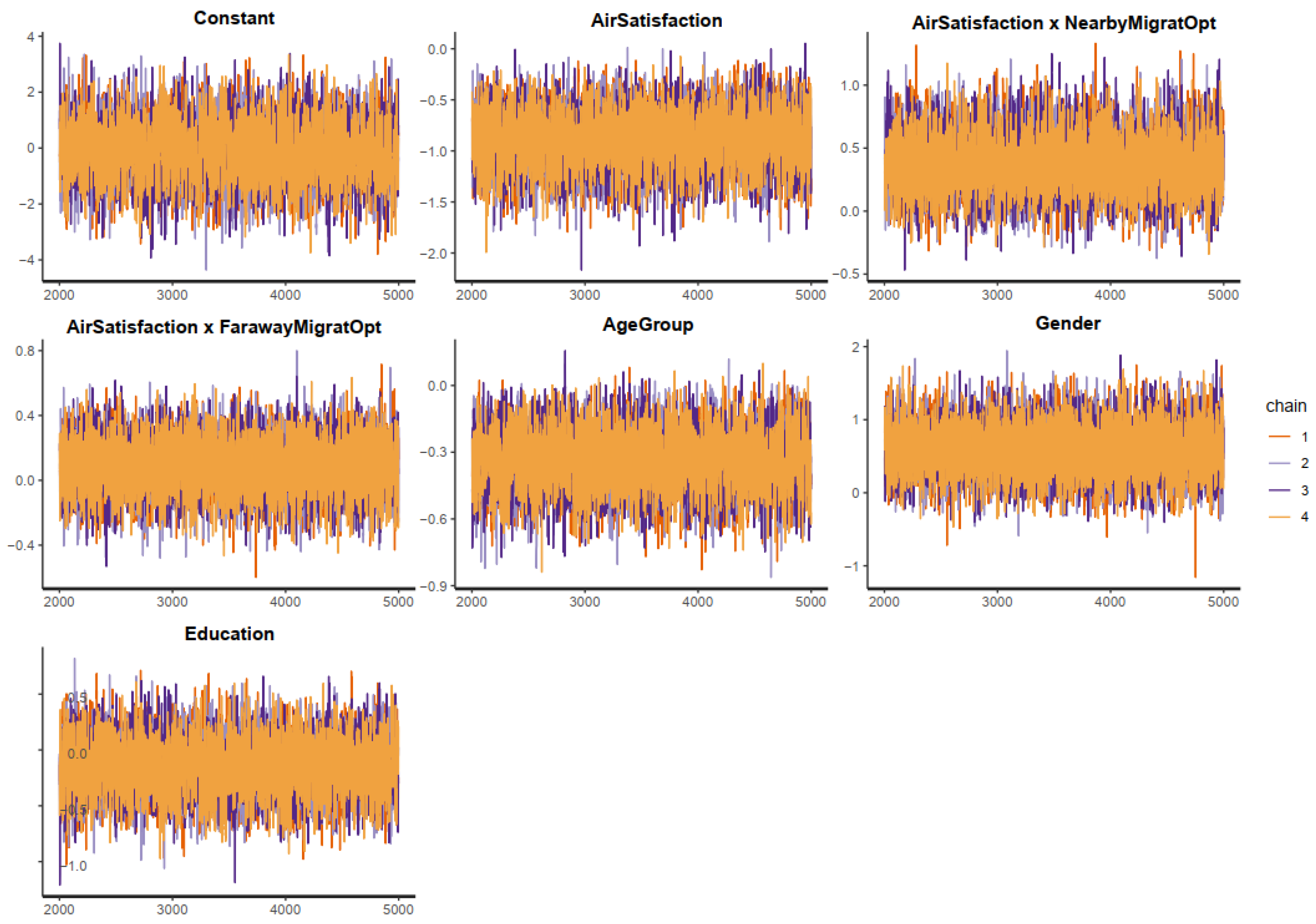
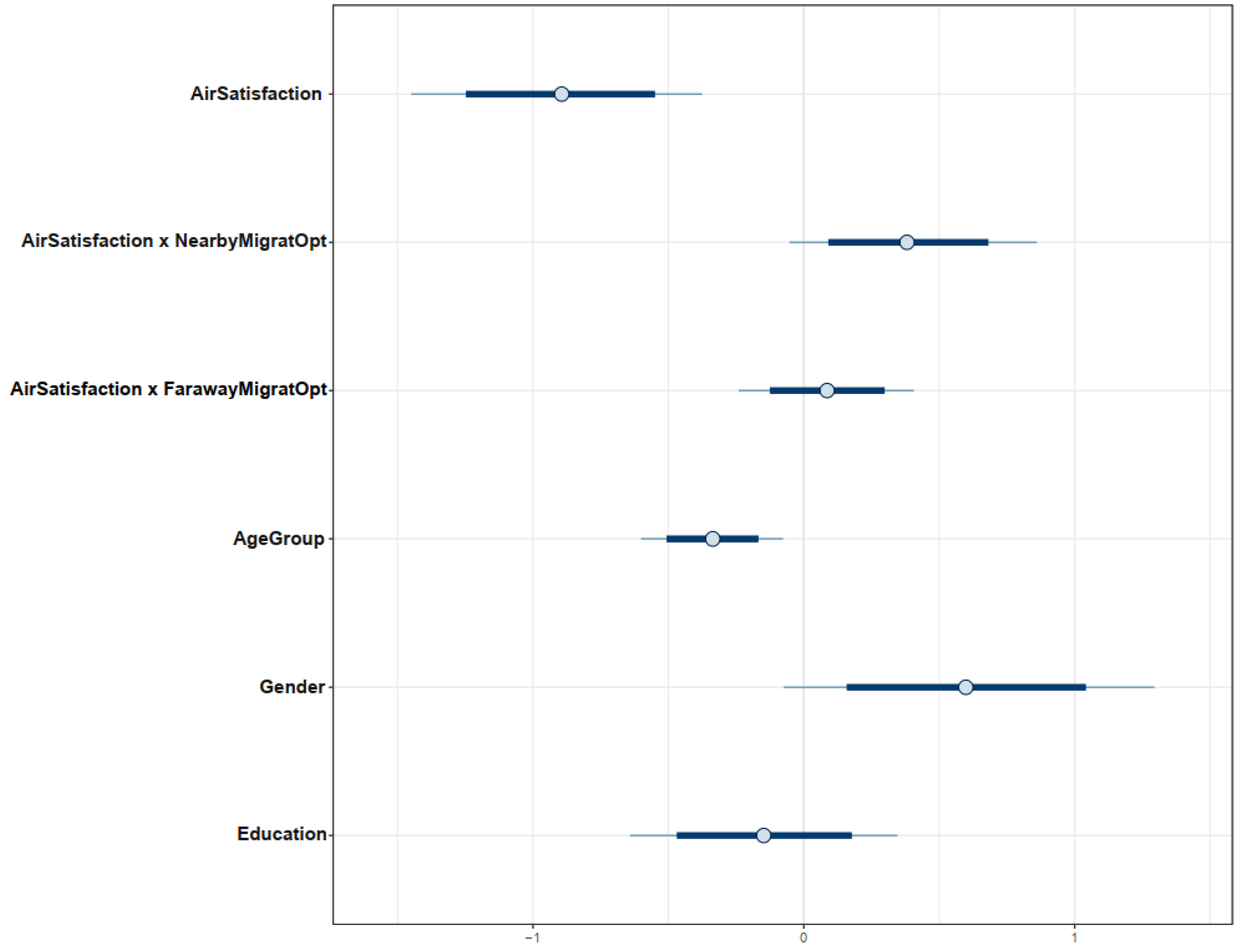

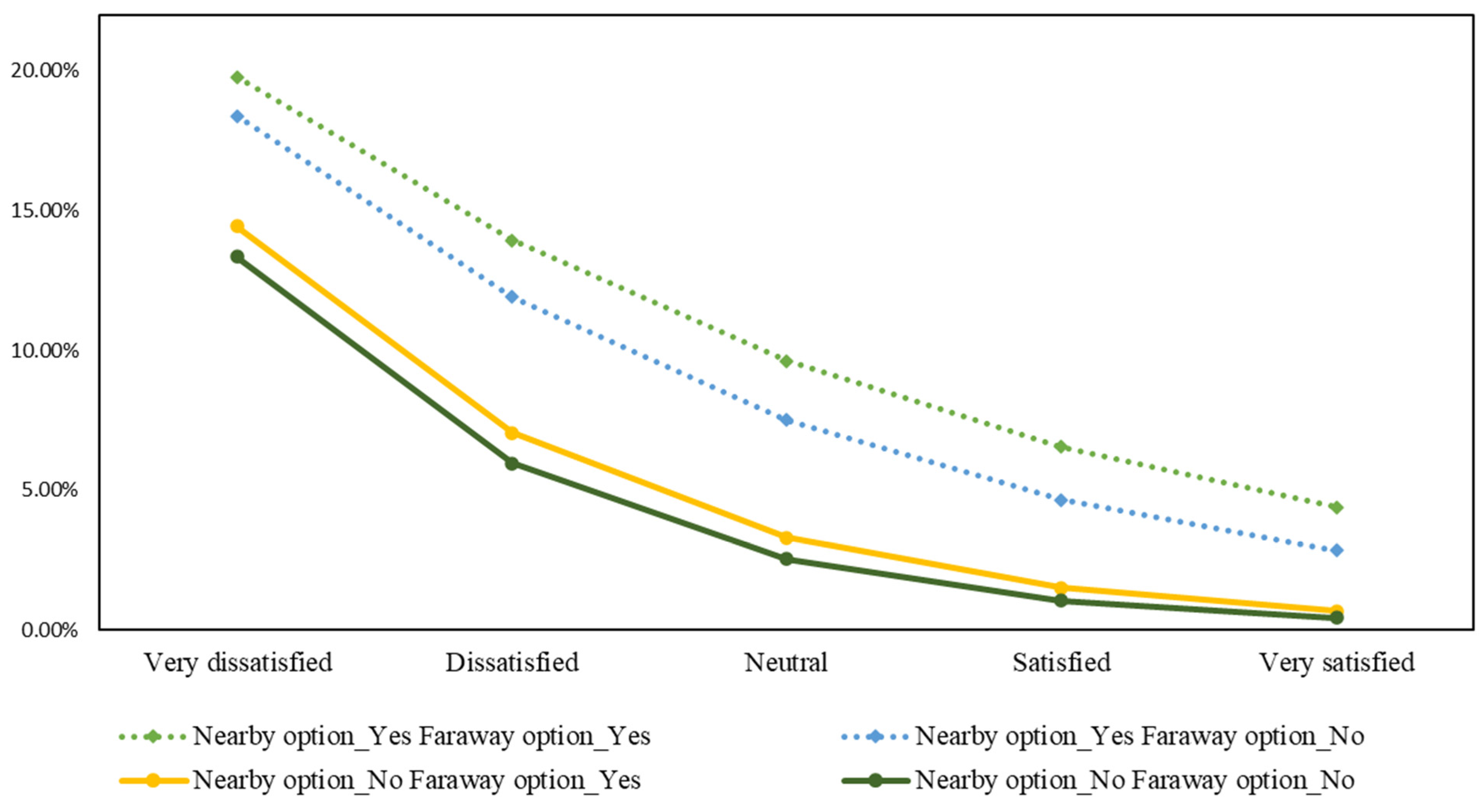
| Variable | Meaning | Type of Variable | Value |
|---|---|---|---|
| MigratIntention | Whether the respondent had the intention to immigrate to another province/city due to air pollution | Binary | Yes = 1 No = 0 |
| AirSatisfaction | The respondent’s satisfaction level with the current air quality | Ordinal | From 1 (very dissatisfied) to 5 (very satisfied) |
| NearbyMigratOpt | Whether the respondent knows a better nearby option to migrate. In other words, whether the respondent perceived that neighboring provinces/cities had better air quality | Binary | Yes = 1 No = 0 |
| FarawayMigratOpt | Whether the respondent knows a better faraway option to migrate. In other words, whether the respondent perceived that Southern provinces/cities had better air quality | Binary | Yes = 1 No = 0 |
| AgeGroup | The age group that the respondent belongs to | Ordinal | From 10 to 18 = 1 From 19 to 30 = 2 From 31 to 40 = 3 From 41 to 50 = 4 From 51 to 60 = 5 Above 60 = 6 |
| Gender | Gender | Binary | Male = 1 Female = 0 |
| Education | The highest achieved level of education of the respondent | Ordinal | Secondary school or below = 1 High school = 2 Technical school, college degree, university degree = 3 Master’s degree = 4 Doctoral degree = 5 |
| Parameters | Priors Reflecting Belief on Effects | Priors Reflecting Disbelief On Effects | ||||||
|---|---|---|---|---|---|---|---|---|
| Mean | SD | n_eff | Rhat | Mean | SD | n_eff | Rhat | |
| Constant | −1.41 | 0.42 | 7081 | 1 | −1.60 | 0.42 | 6532 | 1 |
| AirSatisfaction | −0.86 | 0.27 | 5588 | 1 | −0.47 | 0.24 | 5623 | 1 |
| AirSatisfaction × NearbyMigratOpt | 0.42 | 0.23 | 6662 | 1 | 0.13 | 0.19 | 6751 | 1 |
| AirSatisfaction × FarawayMigratOpt | 0.15 | 0.16 | 8217 | 1 | 0.07 | 0.16 | 8623 | 1 |
| Parameters | Priors Reflecting Belief on Effects | Priors Reflecting Disbelief on Effects | ||||||
|---|---|---|---|---|---|---|---|---|
| Mean | SD | n_eff | Rhat | Mean | SD | n_eff | Rhat | |
| Constant | −0.11 | 1.06 | 4779 | 1 | −0.45 | 1.03 | 4588 | 1 |
| AirSatisfaction | −0.89 | 0.27 | 6712 | 1 | −0.49 | 0.24 | 7273 | 1 |
| AirSatisfaction × NearbyMigratOpt | 0.38 | 0.23 | 7151 | 1 | 0.08 | 0.20 | 8332 | 1 |
| AirSatisfaction × FarawayMigratOpt | 0.09 | 0.17 | 10,652 | 1 | 0.00 | 0.16 | 12,045 | 1 |
| AgeGroup | −0.34 | 0.13 | 6461 | 1 | −0.34 | 0.13 | 7147 | 1 |
| Gender | 0.60 | 0.35 | 10,751 | 1 | 0.59 | 0.34 | 11,862 | 1 |
| Education | −0.15 | 0.25 | 5810 | 1 | −0.09 | 0.25 | 5923 | 1 |
| WAIC | Pseudo-BMA without Bayesian Bootstrap | Pseudo-BMA with Bayesian Bootstrap | Bayesian Stacking | |
|---|---|---|---|---|
| Model 1 | 0.13 | 0.13 | 0.31 | 0.33 |
| Model 2 | 0.87 | 0.87 | 0.69 | 0.67 |
Publisher’s Note: MDPI stays neutral with regard to jurisdictional claims in published maps and institutional affiliations. |
© 2022 by the authors. Licensee MDPI, Basel, Switzerland. This article is an open access article distributed under the terms and conditions of the Creative Commons Attribution (CC BY) license (https://creativecommons.org/licenses/by/4.0/).
Share and Cite
Vuong, Q.-H.; Le, T.-T.; Khuc, Q.V.; Nguyen, Q.-L.; Nguyen, M.-H. Escaping from Air Pollution: Exploring the Psychological Mechanism behind the Emergence of Internal Migration Intention among Urban Residents. Int. J. Environ. Res. Public Health 2022, 19, 12233. https://doi.org/10.3390/ijerph191912233
Vuong Q-H, Le T-T, Khuc QV, Nguyen Q-L, Nguyen M-H. Escaping from Air Pollution: Exploring the Psychological Mechanism behind the Emergence of Internal Migration Intention among Urban Residents. International Journal of Environmental Research and Public Health. 2022; 19(19):12233. https://doi.org/10.3390/ijerph191912233
Chicago/Turabian StyleVuong, Quan-Hoang, Tam-Tri Le, Quy Van Khuc, Quang-Loc Nguyen, and Minh-Hoang Nguyen. 2022. "Escaping from Air Pollution: Exploring the Psychological Mechanism behind the Emergence of Internal Migration Intention among Urban Residents" International Journal of Environmental Research and Public Health 19, no. 19: 12233. https://doi.org/10.3390/ijerph191912233








